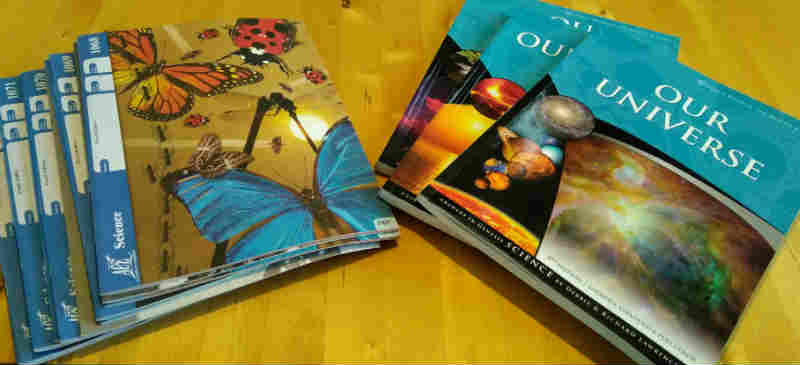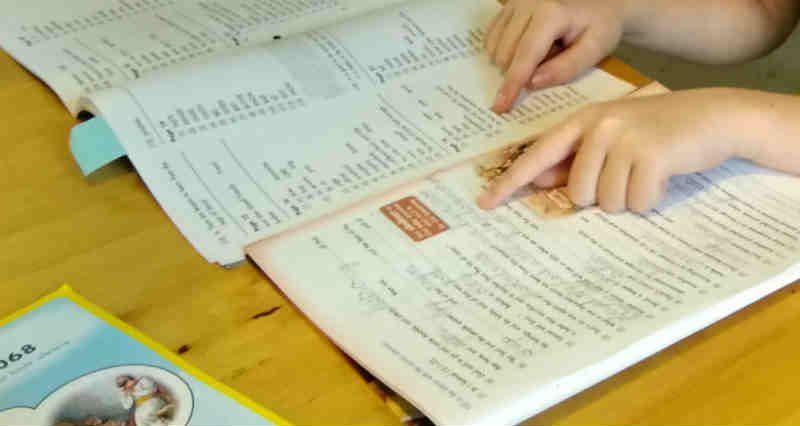
In 2012 I purchased the God’s Design for Heaven and Earth curriculum from Answers in Genesis. At the time my kids were ages 14, 12, 8, 6, and 6. I enjoyed using this adaptable curriculum which was meaty enough curriculum to challenge my older kids and simple enough for my younger ones to learn on their level as well. I read the introductory, Beginner, section to my younger kids and then worked through the remainder of the lesson with my older ones.
Even though the lessons were very well planned, using the curriculum this way required a lot of teaching time for me, and it was easy to for me feel overwhelmed and get burned out, even though we actually skipped many of the hands-on activities the text suggested. We only used the curriculum for two thirds of a school year, completing 2 of the the 3 units I had purchased.
In the years that followed, we explored other curriculum options which enabled my children to work more independently. We settled into using PACEs from ACE (Accelerated Christian Education) for most subjects. The PACEs are easy to implement, seem to have the right amount of challenge for all ages, and are not heavy on the hands-on activities I find particularly challenging. Best of all, my kids can complete the work completely independently, leaving me free to supervise and answer any questions they have.

This year one of my twins, now nearly 12 years old, asked if she could use a curriculum that didn’t require so much writing. She told me that the writing was really slowing her learning down. I had just taken inventory of all the curriculum I had ever used. I considered pulling out Apologia’s General Science and went to my curriculum stash to see if I could locate it. I prayed for God to guide me to the curriculum that we should use. Even though I had pulled the Apologia materials out for reference last year, I could not find them.
Instead my eyes fell on the God’s Design for Science curriculum. I thought back to the challenges I faced 6 years ago and realized they would not be an issue if the twins used the curriculum together, reading it independently. There were questions for every lessons, but those could be answered orally. The girls could even get creative in how they answer them if they like - they could draw pictures, make a video, create PowerPoint slides, make up a song, or otherwise use their imagination in answering them if they chose to. Alternatively, of course, they could just tell me the answers.
I showed the books to the daughter who had asked about a curriculum change, and she was immediately excited. Instead of the workbook format she has been using for the last 3 years, she just gets to read and interact with the text. There are worksheets to go with some of the lessons, and quizzes and tests round out the curriculum, but there is far less writing than in the ACE materials.
When I started setting up this curriculum, I was a bit concerned that I would have a hard time printing the worksheets, which came on a CD included in the teacher guide. My computer now has no CD drive. However, when I went to Answers in Genesis website, I discovered the worksheets are now available as free downloads! I downloaded, printed them, and placed them all in a 3-ring binder for each girl. I also printed the quizzes and included them in each girl’s notebook. I printed out the test for the first unit and placed it in a separate binder where I keep all my kids’ upcoming tests.

The girls chose to start with the “Our Universe” unit. Every morning they start their day with science. Snuggling together on the sofa, they read the lesson, talking about the questions as they go. One twin has started writing down the answers using the notepad app on her cell phone. When they’ve completed all the reading, we talk together about the questions in the text. My part is easy since all the questions and the correct answers are in the accompanying teacher guide. When necessary, I guide them back to the text or ask them additional questions to help them discover a more complete answer.
One of the early lessons asked them to research some scientists throughout history, discuss the space model (geocentric or heliocentric) that was accepted in their time, and learn about contributions they made toward what we now know about the structure of our solar system. It was a tough assignment for them, but they tried as hard as they could on their own before I saw how hard they were struggling; I stepped in and helped direct them to the information they needed.
The twins are hooked on this curriculum! Even though their science lessons are actually taking them longer, it’s much more enjoyable for them. They are thinking much more deeply about science. The questions in the book certainly challenge them, and they are learning much more than with the PACEs. I absolutely love the creation science focus of this curriculum.
My daughter has already asked me if we’re going to go back to PACEs after they finish studying the material we have. I expect that at some point we may return to PACEs for their high school work. But I’m really looking forward to ordering other units after they complete the units we already have. I’m so glad we rediscovered it before they were too advanced in science to justify using it!